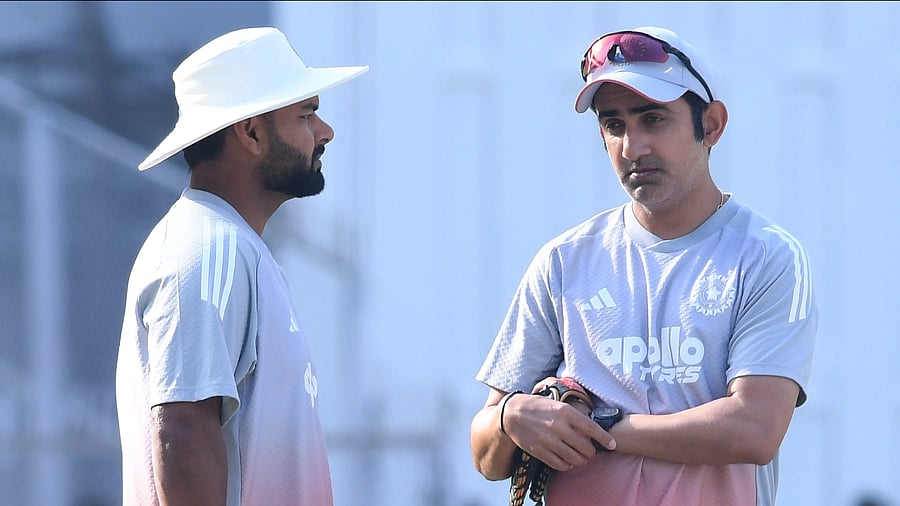
While head coach Gautam Gambhir has enjoyed a lot of success in limited-overs, he’s been found wanting in Tests.
Credit: PTI photo
Guwahati: Gautam Gambhir has often expressed his dislike for the word transition. On Wednesday afternoon in Guwahati, however, he used that very term repeatedly after India suffered a heavy 408-run defeat against South Africa in the second Test.
According to him, Indian cricket is going through a phase where both the batting and spin bowling units are experiencing transition while emphasising that this is the first time such a situation has occurred in both departments simultaneously.
He was obviously referring to the recent retirements of Virat Kohli, Rohit Sharma and R Ashwin, which took place within a short period since December last.
There is some merit in his argument regarding the batting. In the second Test, India fielded Sai Sudharsan, Dhruv Jurel, and Nitish Reddy, who collectively had only 22 Tests to their names before the match. However, the transition theory does not hold as well when applied to spin bowling.
Spin has seen transitions before. When leg-spinning great Anil Kumble retired in November 2008, Harbhajan Singh became India’s lead spinner until Ashwin arrived in November 2011.
By then, Harbhajan’s role was already diminishing and featured in only five more Tests after Ashwin’s debut. Ravindra Jadeja joined the squad in 2012 while Amit Mishra remained in the picture.
Jadeja continues to excel and shows no signs of decline. Kuldeep Yadav has played only 17 Tests but has been part of the Test setup for nearly eight years. He cannot be described as inexperienced.
He has even played more Tests than South Africa’s Simon Harmer, who took 17 wickets in the two-match series. Washington Sundar has not yet bowled much in Test cricket but remains a viable third spinner if required. Most successful teams rarely have every player fully experienced at the same time. The real issue in the series was not transition but that South Africa’s spinners outperformed India’s.
While the batting unit lacked experience, it could still have been more competitive. The team selection strategy leaned towards including all-rounders, regardless of whether they merited their places. All-rounders are a tremendous asset in white-ball formats because they offer depth and balance.
They are even more valuable in Test cricket, but only when they can justify their selection based solely on either batting or bowling. The great all-rounders like Kapil Dev, Ian Botham, Imran Khan, Jacques Kallis, and in modern times Ben Stokes, could all command a place in the team purely through one discipline.
This leads to a crucial question regarding Nitish Reddy. If he bowls only 10 overs across two innings, he is effectively selected as a specialist batter. At this stage, he has not yet proved he can secure a place in the Test side solely on batting ability. Test cricket demands specialisation and skill sustained across long periods. Although Nitish scored a century in Australia, it came in a rather T20 style. Currently he remains a one-dimensional batter, and selecting too many players like him reflects a defensive mindset rather than a strategy designed to win Tests. Teams benefit greatly from batters who can bowl a little or bowlers who can bat respectably. But relying on bits and pieces players doesn't provide the requisite strength.
Compounding this issue is the lack of stability in selection. Players are frequently picked and dropped without clear reasoning, resulting in an unsettled dressing room. Nitish was initially released before the first Test in Kolkata so he could play the India A one-day series against South Africa A. He was then recalled after two matches once Shubman Gill suffered an injury. He was drafted in the XI after merely two days of preparation. Washington Sundar’s situation is equally puzzling. Despite consistent batting performances, he has been shuffled in the order. He batted at No. 3 in the first Test but was pushed down to No. 8 in the second. Such inconsistent planning benefits no one.
India’s recent struggles cannot be attributed solely to Gambhir’s coaching. Several batters have displayed poor temperament in key moments. The collapse from 95 for one to 201 all out in the first innings of the second Test reflected more of mental lapses. Still, the coaching staff can't escape the responsibility for failing to build an environment where players are best prepared to succeed in the longest format.
This situation raises a broader question. Gambhir has achieved considerable success in white-ball formats, but it remains uncertain whether he is the right person to guide the Test side. If he continues in this role, the BCCI officials, the leadership group in the squad and the support staff must engage in honest discussions and establish a clear plan to move forward.